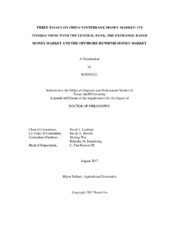| dc.description.abstract | This dissertation consists of three essays that focus on China’s interbank money market. The first essay is an empirical examination of the responses of China’s short-term interbank interest rates to the People’s Bank of China (PBOC)’s policy instruments, and how these responses were affected by structural changes. The results indicate that the interbank interest rates responded to policy instruments differently following three structural changes related to the 2007-08 global financial crisis and major operational changes by the PBOC in 2011 and 2013. The results also suggest that there were significant discrepancies between the Shanghai Interbank Offered Rate (SHIBOR) and the interbank repo rate’s responses to policy instruments.
The second essay is an empirical assessment of the transmission of liquidity shocks between China’s interbank money market that supplies liquidity to the banking sector and China’s exchange-based money market that supplies liquidity to the stock market, based on the co-movements of interest rate spreads in these two markets. The segmentation between the two money markets was supposed to prevent the transmission of liquidity shocks between China’s banking sector and stock market during liquidity-related market events. However, the results in this study suggest that the trading and financing activities in the two money markets allowed liquidity shocks to circumvent the market segmentation during two recent market events, including the rollercoaster ride of China’s stock market in 2014-15 and the cash crunch in China’s banking sector in mid-2013.
The third essay is an attempt to infer how China’s monetary policymakers may have handled the famous monetary policy trilemma based on an empirical exploration of the interactions between the onshore and offshore renminbi interbank interest rates. The results suggest that, during most of the last three to four years, the monetary policymaking of the PBOC has been bounded by the trilemma like the central banks in the other major economies, with the exception of a 15-month period since May 2014. The results also suggest that the PBOC may have switched their priorities among the three components of the trilemma several times in recent years in responses to different market environments. | en |


